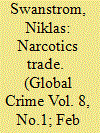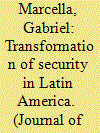|
|
|
Sort Order |
|
|
|
Items / Page
|
|
|
|
|
|
|
| Srl | Item |
| 1 |
ID:
078966


|
|
|
|
|
| Publication |
2007.
|
| Summary/Abstract |
Traditional definitions of security have tended to concentrate on the state and military threats to its sovereignty. However, in the post-Cold War world, it is clear that a much more nuanced perspective is required, also considering a variety of so-called 'soft' security issues such as social, human and environmental threats. Furthermore, this must appreciate the extent to which these varied threats are integrated. The expanding narcotics trade provides an excellent example of the way global crime creates and facilitates this kind of integrated threat. In both production and transit regions, it generates a variety of interconnected threats to political, economic, human and military security. It thus requires solutions which integrate responses to these various threats and also operate at the local, national, regional and global level.
|
|
|
|
|
|
|
|
|
|
|
|
|
|
|
|
| 2 |
ID:
121549


|
|
|
|
|
| Publication |
2013.
|
| Summary/Abstract |
Since the end of the Cold War, there has been a transformation of security in Latin America. Latin American countries have been moving toward the concepts of multidimensional security and security of the individual and society, and away from the classical understanding of the security dilemma posed by an external threat to the state. Illegal narcotics, the proliferation of guns, and other transnational threats, combined with undergoverned space and the weak state syndrome, generated an extraordinary crime wave, which gives the region the highest murder rate in the world. Moreover, crime imposes a heavy cost on economic growth and democratic governance. This insecurity crosses international borders, and the institutions of public security-police, military, and judicial systems-are hard pressed to meet the challenge. The privatization of security is a symptom of the problem and a potential source of abuse. The United States shares responsibility for the violence due to U.S. demand for illegal drugs and the fact that it is a supplier of arms to Latin America. At the same time, there is a growing consensus in support of common action, as evidenced by the international coalition that is operating under Operation Martillo-the antinarcotics effort in the Caribbean and Central America. Moreover, a number of Latin American countries contribute to international peace operations. Accordingly, the new strategic consensus among Latin American countries should be a cause for common action.
|
|
|
|
|
|
|
|
|
|
|
|
|
|
|
|
|
|
|
|
|